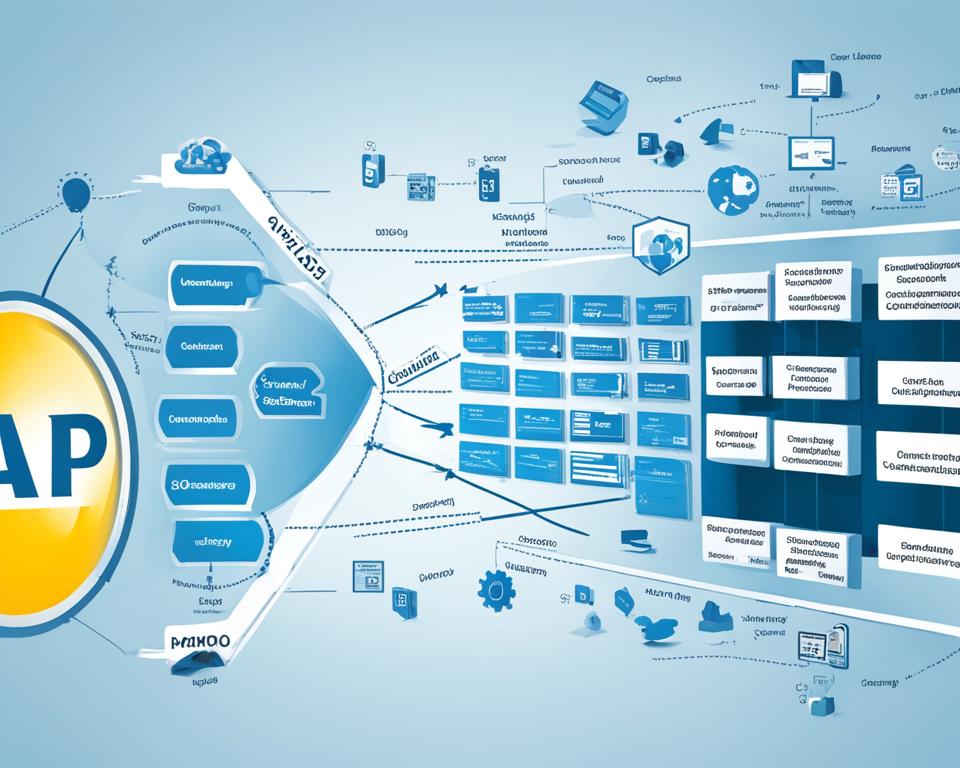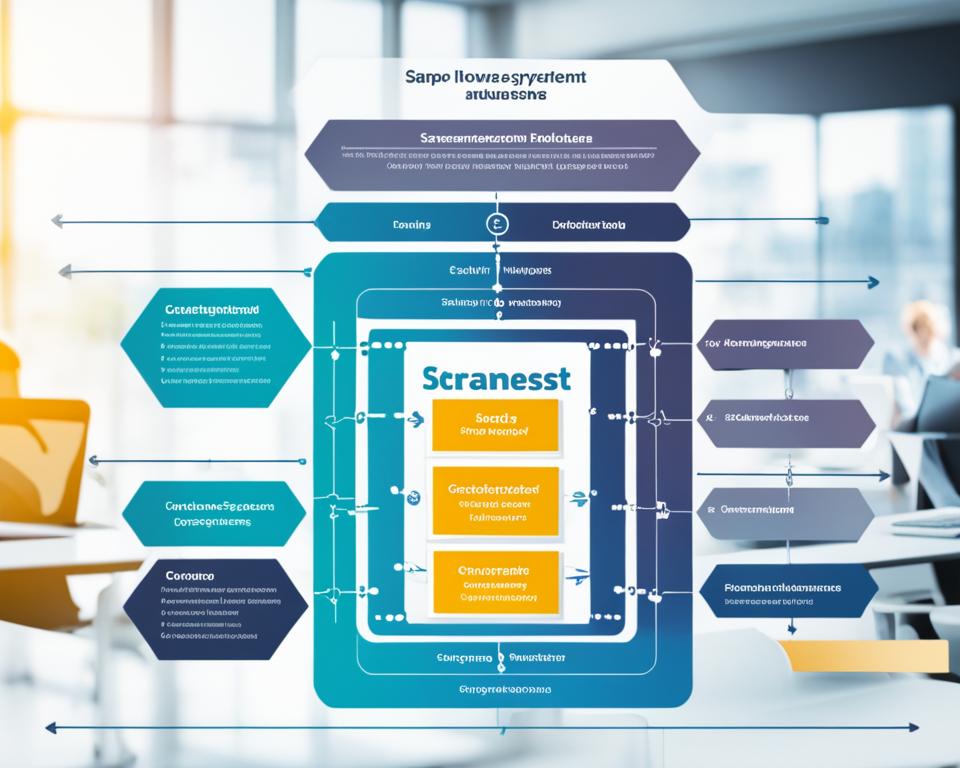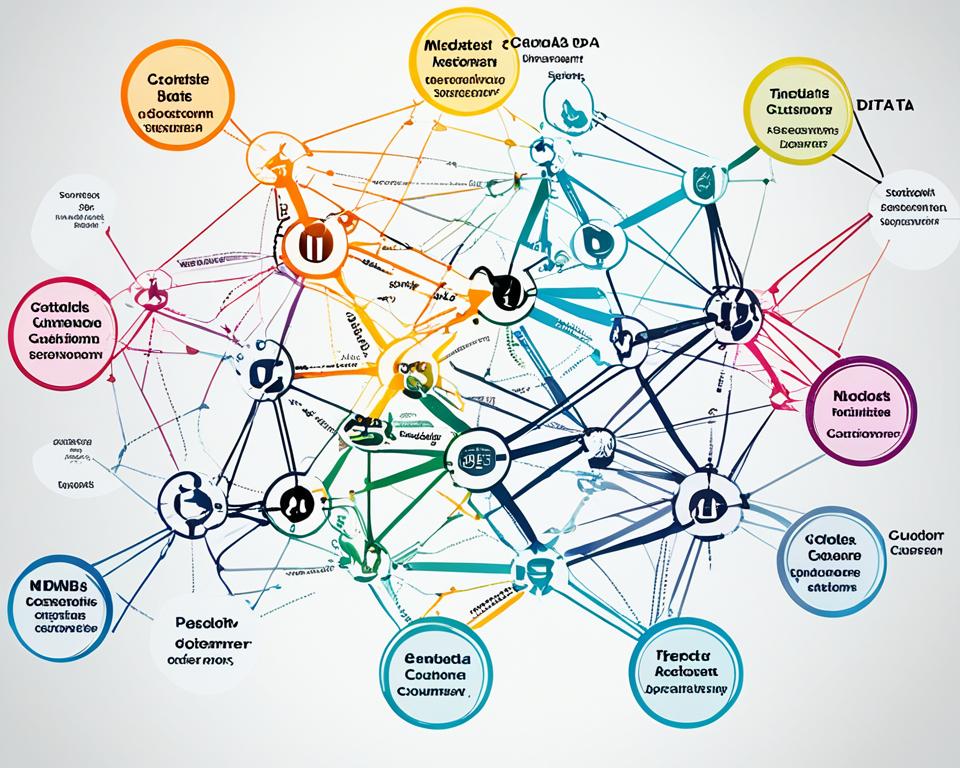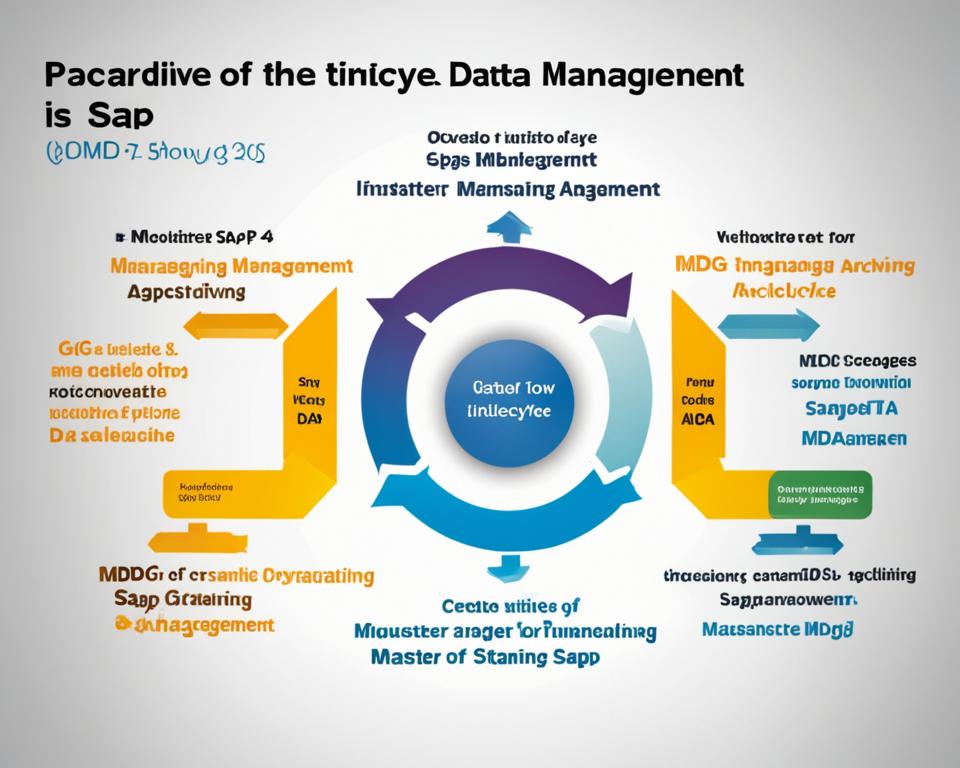Have you ever thought about how a single wrong data entry could mess up an entire business? In today’s fast world, managing master data well is key. SAP MDG is a solution that boosts data quality and makes governance smoother and speeds up business processes. This article will show how SAP MDG changes how we manage master data in companies. Let’s see how getting better at managing data can lead to success.
Key Takeaways
- SAP MDG enhances overall data quality.
- Effective master data management is essential for smooth business operations.
- Streamlining governance processes leads to increased efficiency.
- Improved data management can accelerate business decision-making.
- A strong foundation in master data management protects against costly errors.
Understanding Master Data Management
Master Data Management (MDM) makes sure an organization’s key data is consistent, accurate, and reliable. It puts all important data in one place and controls it. This helps organizations manage their data well and set strong data rules. It needs a team effort from different people, tools, and steps to give everyone the same view of the data.
What is Master Data Management?
MDM uses processes and tools to keep an organization’s important data in check. It deals with things like customers, products, suppliers, and locations. Having one correct place for this data improves its quality in all systems and apps. But, MDM faces challenges like getting data in line across departments, avoiding duplicates, and fixing errors that happen over time.
The Importance of Master Data Quality
Good data quality is key for doing things well and making smart choices in any business. Bad data can lead to wrong plans, slow work, and missed chances. Strong data rules help keep data reliable and consistent. Good processes for adding, checking, and keeping data right make it better. This lets companies change easily while keeping data quality high.
What is SAP MDG?
SAP Master Data Governance (MDG) is a special solution for better Master Data Governance in companies. It helps manage master data well, making sure the right data is there when needed for good decisions.
An Overview of SAP MDG’s Capabilities
SAP MDG has key features like data modeling, integration, workflow management, and strong data governance. It’s a vital tool for companies wanting to keep their master data top-notch from start to finish.
It lets users create and handle master data structures well with its data modeling. The integration features connect easily with SAP ERP systems, making data move well between departments.
Workflow management in SAP MDG makes processes smoother, cutting down on manual work and mistakes. Automating workflows boosts efficiency and accuracy. The platform also supports strong data governance, pushing for responsibility and care in managing data.
For those eager to improve procurement, using SAP MDG can greatly improve procurement and build stronger supplier ties.

The Benefits of SAP MDG for Businesses
In today’s fast-paced business world, companies look for tools to make things run smoother and work better. SAP Master Data Governance (MDG) offers big advantages for businesses. It helps make data better and more consistent, and it speeds up business processes with better governance.
Enhanced Data Quality and Consistency
The top benefit of SAP MDG is its power to boost data quality and consistency. It makes sure master data is correct, current, and the same everywhere in the company. This means fewer mistakes and less waste.
Faster Business Processes with Streamlined Governance
Also, SAP MDG makes business processes quicker. It helps validate data faster and makes it easier to get to. This leads to better decision-making and helps companies work better with suppliers and drive digital changes. Many companies, like those in real-world case studies, have seen big gains in efficiency by using SAP solutions.
| Benefit | Description | Impact |
|---|---|---|
| Enhanced Data Quality | Improvements in accuracy and consistency through rigorous governance. | Reduces errors and ensures reliable information. |
| Streamlined Governance | Efficient processes for data validation and accessibility. | Enables faster decision-making and operational efficiency. |
Data Governance in SAP MDG
Data governance is key to managing master data well in organizations. In SAP MDG, it’s vital to set rules for data integrity, accuracy, and transparency. These principles help in making data quality and compliance better.
Key Principles of Data Governance
Good data governance relies on several important principles. These guide how to manage data assets:
- Accountability: Clear data ownership ensures clear responsibilities.
- Integrity: High data quality builds trust for decision-making.
- Transparency: Open talks about data processes and policies helps everyone understand and follow them.
- Compliance: Following laws is key to meeting legal and ethical data governance standards.
- Collaboration: Working together across departments makes data stewardship better by using different insights.
How SAP MDG Supports Data Stewardship
SAP MDG is key in helping with data stewardship. It gives tools and frameworks that help data stewards. These features support managing master data well:
- Role Assignment: Helps pick data stewards to keep data quality up.
- Workflow Management: Makes processes for data creation, change, and approval smoother, following governance rules.
- Audit Trails: Keeps detailed logs of data changes and access, promoting accountability and openness.
- Reporting Tools: Helps watch data quality metrics, spotting areas to get better.

Master Data Governance with SAP MDG
Getting a unified view of master data is key in master data governance. It makes sure all parts of the business use the same terms and standards. This approach helps manage data better, improving how the company works and makes decisions.
Creating a Unified View of Master Data
A unified master data strategy means bringing together different data sources. It keeps the data accurate and reliable. Standardized processes create one true version of the data.
This strategy lets people in different departments see the same data. It helps them work together better and lessens disagreements. Having one view of the data is vital to avoid repeating information and mistakes.
Implementing Data Harmonization Strategies
Data harmonization makes different datasets work together smoothly. It turns varied data into one format, making it better quality. This makes data more reliable and useful for business.
It also makes business processes run smoother. Companies that focus on data harmonization work better, follow rules better, and have stronger data management.
| Strategy | Description | Benefits |
|---|---|---|
| Standardization | Creating common data definitions across systems | Improved data quality and consistency |
| Data Cleansing | Removing duplicates and correcting errors in datasets | Enhanced accuracy and reliability |
| Metadata Management | Establishing guidelines for data definitions and uses | Better understanding and utilization of data |
| Continuous Monitoring | Regular assessments of data integrity and compliance | Proactive management of data quality issues |
In SAP MDG, these strategies work well together. They focus on unified master data and data harmonization. This helps businesses work better and make smarter decisions. For more on how technology helps with these strategies, check out this resource on SAP and ABAP.
Data Integration Strategies in SAP MDG
Data integration is key in managing data well. SAP MDG connects diverse data sources effectively. This makes sure data moves smoothly between systems and boosts visibility in an organization. Knowing how to integrate data well can make data better and easier to get to.
Connecting Diverse Data Sources
Linking diverse data sources is crucial for using all your data fully. SAP MDG helps me bring different data together into one system. This way, data updates in real-time and stays correct on all platforms. Some top ways to connect well include:
- Using APIs for real-time data interactions.
- Setting up ETL (Extract, Transform, Load) for batch data integration.
- Using data virtualization to get to data without moving it physically.
Optimizing Data Integration Processes
Improving data integration makes SAP MDG work better. With smart strategies, I can cut down on extra data and stop data from getting stuck in silos. Important steps are:
- Standardizing data formats to make them work better together.
- Using data governance rules for following laws and keeping data quality high.
- Checking and auditing data flows often to fix any issues fast.
For more info on tools and parts that help with data consistency, check out the ABAP Dictionary. It’s key in keeping SAP systems’ data right.

The Role of Data Modeling in SAP MDG
Data modeling is key in SAP MDG. It helps organizations understand how data connects. This makes data better managed and of higher quality.
Understanding Data Modeling Techniques
There are many ways to model data effectively. These include:
- Entity-Relationship Diagrams (ERDs) – These show how data and its connections look.
- Normalization – It organizes data to cut down on repetition.
- Data Flow Diagrams (DFDs) – These show how data moves in a system.
Benefits of Effective Data Modeling
Using good data modeling in SAP MDG has many perks. These are:
- Improved Communication – It makes data relationships clear, helping everyone understand better.
- Enhanced Data Integrity – It helps avoid mistakes and keeps data consistent.
- Streamlined Governance – It makes managing data in the company easier.
Investing in data modeling is crucial for getting the most out of SAP MDG. It boosts data quality and supports strong data governance.
| Technique | Description | Benefits |
|---|---|---|
| Entity-Relationship Diagrams | Visual maps of data entities and their interrelations | Enhances clarity and communication |
| Normalization | Structuring data to eliminate redundancy | Improves data integrity |
| Data Flow Diagrams | Depicts the movement of data in systems | Aids in understanding process dynamics |
Metadata Management in SAP MDG
Understanding metadata management in SAP MDG is key for any company wanting to boost data quality. Metadata is all about giving context to data. It tells us where the data comes from, its structure, and the rules that apply to it. This makes it essential for good data management and governance.
What is Metadata and Why is it Important?
Metadata is often called data about data. It’s crucial because it controls how we handle and access data. By using SAP MDG with strong metadata management, companies can make their data better. Good metadata helps spot mistakes and make sure decisions are based on solid data.
Using Metadata for Enhanced Data Quality
Using metadata well can greatly improve data quality. Companies can set up metadata strategies that help with better data governance. This lets teams handle their data better. Some key ways include:
- Setting clear metadata standards and policies.
- Using automated tools to keep metadata up-to-date.
- Training data stewards on how to use metadata.
These steps don’t just make data better. They also help users make smart choices. This supports the success of the business.

Implementing SAP MDG
Implementing SAP MDG needs a series of steps. First, we look at how data is managed now. This helps us see where we need to improve. Then, we start a structured process for a smooth transition through each phase.
Steps to Implement SAP MDG in Your Organization
- Conduct a comprehensive needs assessment to identify gaps in the current data management framework.
- Define the scope of the SAP MDG implementation based on organizational requirements and objectives.
- Develop a detailed project plan outlining all stages of the process, including timelines and resource allocation.
- Engage relevant stakeholders to obtain buy-in and support for the project.
- Provide training for users to familiarize them with SAP MDG functionalities.
- Launch a pilot implementation to test the system in a controlled environment.
- Roll out the full implementation once the pilot demonstrates success, while ensuring to monitor and optimize regularly.
Challenges and Solutions During Implementation
Implementing SAP MDG can come with challenges. Issues like inconsistent data, resistance to change, and poor training can slow things down. Here are some ways to overcome these:
- Develop a comprehensive data cleansing plan to standardize data formats before migration.
- Foster a culture of change by communicating the benefits of the new system to all stakeholders.
- Implement ongoing training sessions to ensure users are confident and competent in using SAP MDG.
- Establish a dedicated support team to assist users and troubleshoot issues promptly.
Data Lifecycle Management with SAP MDG
Managing data from start to finish is key for keeping information reliable and in line with rules. SAP MDG helps me manage data creation, upkeep, and deletion in a clear way. This method boosts data quality and makes business processes smoother.
The Importance of Managing Data Throughout Its Lifecycle
Each step in the data lifecycle is vital for keeping data correct and useful. From the moment it’s created to when it’s archived or deleted, managing data well reduces risks of misuse and errors. This full lifecycle approach helps meet industry standards and builds trust in the data for making decisions.
Strategies for Effective Data Lifecycle Management
For good data lifecycle management in SAP MDG, there are several important steps:
- Standardization of Data Entry: Clear rules for data entry prevent early mistakes.
- Regular Audits: Periodic checks ensure data is correct and follows rules, keeping quality up.
- Automated Workflows: Automated updates in SAP MDG make data handling smoother and easier to track.
- Clear Archiving Process: A well-planned archiving strategy helps get rid of old data efficiently, saving storage space.
- Training for Users: Teaching people about data lifecycle management spreads a culture of caring for data in the company.

Case Studies: Success Stories with SAP MDG
Looking at real-world uses of SAP MDG shows its big impact on different companies. These stories highlight the challenges faced and the creative ways SAP MDG helped solve them.
Real-World Applications of SAP MDG
Companies from many fields see SAP MDG as a key to better master data management. Here are some main ways they use it:
- Data Harmonization: Many firms have made their data work together better. This reduced data errors.
- Improved Compliance: SAP MDG helps companies follow rules by keeping data accurate and up-to-date.
- Enhanced Collaboration: A unified data source helps teams talk better and make decisions faster.
Measuring ROI from SAP MDG Implementation
The return on investment from SAP MDG can be seen in several ways. These show the real benefits after using it. Here are some key points:
| Metric | Before SAP MDG | After SAP MDG |
|---|---|---|
| Data Entry Errors | 20% | 5% |
| Time Spent on Data Management | 40 hours/week | 15 hours/week |
| Compliance Issues | 15 incidents/year | 2 incidents/year |
These examples show how SAP MDG works well and brings great results. They explain why more companies are choosing this solution.
Future Trends in Master Data Management
The world of master data management is changing fast. New technologies are making a big impact on master data management. We’re seeing a move towards more automated and smart ways of managing data. As companies aim to work better, using artificial intelligence and machine learning is becoming key.
The Evolution of Master Data Management Practices
Technology has changed how I see data governance. Now, companies are using flexible models that help with oversight and follow rules. This is important because we’re dealing with huge amounts of data every day. Keeping data quality high is still a big focus as I look for new ways to manage data well.
Looking ahead, we see several important trends:
- Integration of AI and machine learning to make data processes smoother
- Creating easy-to-use platforms that help teams work together
- Real-time data updates for quicker decision-making
- Stronger rules that shape how we manage data
As I adjust to new needs, I’m checking out tools and tips, like those in the guide to mastering ABAP reports. These guides offer insights that help me meet my goals and understand better how to manage master data well.
| Trend | Description | Impact on MDM |
|---|---|---|
| AI Integration | Use of artificial intelligence to enhance data accuracy and processing speed. | Improved decision-making and efficiency in data management. |
| Real-Time Data Access | Availability of real-time analytics for immediate insights. | Faster response times in business operations. |
| Adaptive Governance Models | Flexible governance approaches tailored to specific organizational needs. | Better compliance and oversight. |
| Regulatory Compliance | Stronger regulations regarding data protection and privacy. | Increased focus on data stewardship and quality management. |
SAP MDG: Streamline Your Master Data Management
Learning about SAP MDG can make managing master data more efficient. It helps organizations improve their data processes and keep master data of high quality. I’ll explain the main parts that make workflows smoother and data governance better.
Key Features and Functionalities Explained
Master data management functionalities of SAP MDG stand out with its strong data modeling. It lets you build complex data structures that match business needs. The platform also has tools for managing workflows that make integrating data across departments easy.
Data validation is key in SAP MDG too. It uses rules to keep data correct and consistent. Audit trails help show who changed data and when, making data management more transparent and accountable.
| Feature | Description | Benefits |
|---|---|---|
| Data Modeling | Comprehensive structure creation for master data. | Reflects business needs accurately. |
| Workflow Management | Automates and streamlines data integration across departments. | Enhances operational efficiency. |
| Data Validation | Implements rules to ensure data accuracy. | Maintains integrity and consistency. |
| Audit Trails | Tracks changes and access to data. | Increases transparency and accountability. |
Best Practices for Master Data Management
Master data management is key to keeping data quality high in an organization. It’s important to have a solid strategy for managing data. This strategy should match the company’s goals, making sure master data stays useful and relevant.
Developing a Comprehensive Master Data Strategy
Creating a strong master data strategy means knowing what the organization needs and wants. I set up clear rules for making, keeping, and using data. These rules focus on:
- Data Governance Framework: This sets up who is in charge of data management.
- Data Ownership: Giving someone in charge of data helps keep it in good shape.
- Continuous Review: Checking on how data is managed helps improve and adapt.
Tips for Maintaining Data Quality and Integrity
To keep data quality high, I follow some key tips. It’s important to keep data entries consistent and accurate. Teaching the team about data governance shows how crucial it is to keep data honest.
I also use tools and tech to check data automatically. Remember, master data management strategies are key for a structured way to improve.
| Best Practices | Description |
|---|---|
| Data Quality Audits | Regular checks to identify and fix data mistakes. |
| Employee Training | Training to keep skills sharp in data management. |
| Data Integration Tools | Using tech to make data flow smoothly. |
| Feedback Loops | Systems for people to report data quality problems. |
These best practices make sure data is reliable and build a culture of responsibility in data management. Following these rules will greatly improve data quality. With hard work and careful attention, achieving top-notch master data quality and integrity is possible.
Training and Support for SAP MDG
Organizations aiming to improve their master data governance with SAP MDG need the right training and support. Using the best resources can boost your skills with this tool.
Resources for Learning SAP MDG
To get to know SAP MDG, look at different training for SAP MDG options. Here are some top choices:
- Formal Training Programs: Many places offer detailed courses on SAP MDG.
- Online Courses: Websites like Coursera or Udemy let you learn at your own pace.
- User Communities: Joining online groups and forums can help you learn from others and share tips.
Where to Find Expert Support
It’s key to find expert help for a successful SAP MDG setup. Here are some great places to look:
- Consulting Firms: Specialized companies can give you specific help with SAP MDG.
- SAP Partners: Working with SAP partners who are certified means you get help from pros who know the system well.
- SAP Resources: SAP’s official guides and support can give you the help you need.
Conclusion
Looking back at this article, it’s clear SAP MDG offers big benefits for companies. It helps improve data quality and make governance smoother. By giving a single view of master data, it boosts efficiency and helps in making better decisions.
Master data management is key to success for any business. With SAP MDG, companies can use top-quality data to stay ahead. This also helps follow rules and builds a culture of data care in the company.
Using SAP MDG is more than just adding a new tool. It’s about a full plan for managing data well. I urge companies to see the great results they can get from SAP MDG. It’s a chance to get strong master data management and better business performance.
FAQ
What is SAP MDG and why is it important?
SAP MDG stands for Master Data Governance. It helps manage master data well. It’s key because it makes sure data is good quality, follows rules, and makes processes smoother. This leads to better decisions and work flow.
How does SAP MDG improve data quality?
SAP MDG makes data quality better by using strict rules for data handling. It uses data stewardship and modeling to keep master data right and the same everywhere in the company.
What are the key features of SAP MDG?
SAP MDG has important features like workflow management and data integration. It also has metadata management and makes master data easy to see. These help with managing data well and keeping it quality.
How does SAP MDG support data governance?
SAP MDG helps with data governance by setting up a clear framework. It makes sure there’s accountability, integrity, and transparency. It lets companies pick data stewards to follow data rules and keep things in line.
What strategies does SAP MDG utilize for data integration?
SAP MDG uses strategies like linking different data sources and making processes better. This helps avoid data silos and makes managing data’s life cycle better.
Can SAP MDG help with data harmonization?
Yes, SAP MDG helps make data the same across the company. This makes master data clear and right, which helps work better.
What role does data modeling play in SAP MDG?
Data modeling in SAP MDG sets up how data should be structured and related. It’s key for keeping data quality high and making sure it shows the right business info.
How does SAP MDG address metadata management?
SAP MDG manages metadata by organizing and controlling it well. This helps with data quality efforts and makes it easier to understand and use data in the company.
What challenges might organizations face when implementing SAP MDG?
Companies might face issues like not wanting to change, problems with integrating with current systems, or not having the right skills. But, with good planning and training, these can be overcome for a successful start.
What are the future trends in Master Data Management?
The future looks bright with trends like AI and machine learning coming into master data management. These will make data governance better and improve data quality and follow rules.


